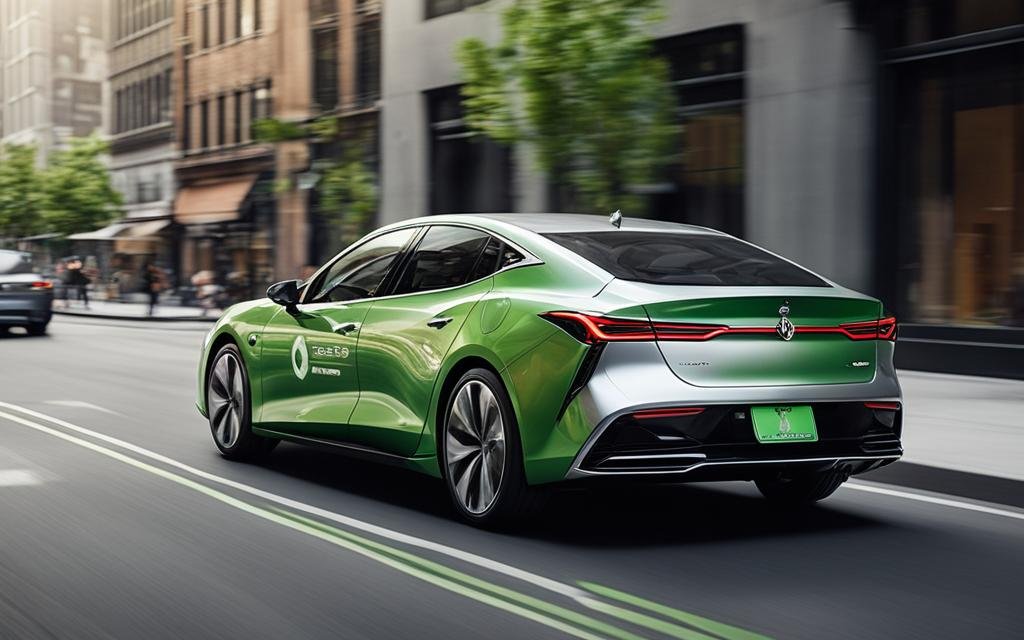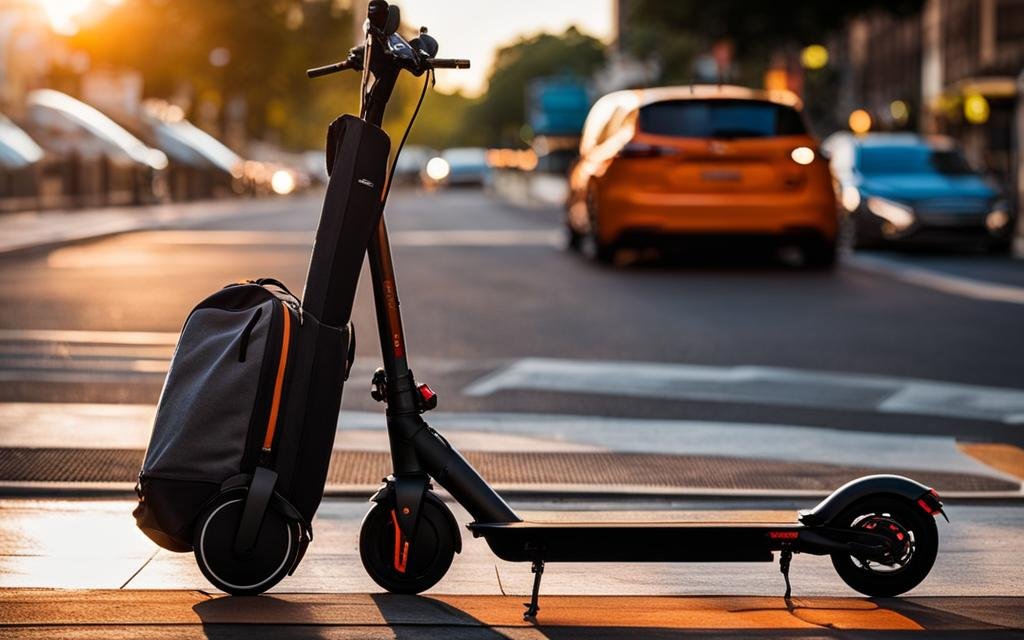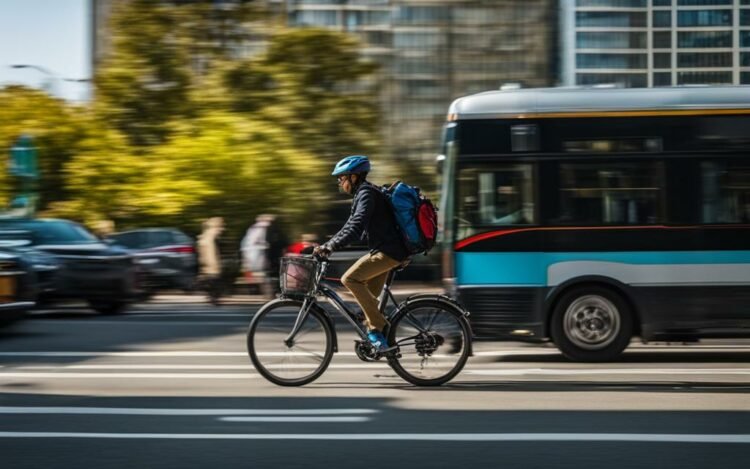Commuting and transportation costs can take a major bite out of your budget. With the average annual cost of owning and operating a new vehicle reaching $10,728 in 2022, finding ways to save money on transportation is crucial. This article will provide practical tips and strategies for cutting costs on transportation, whether you’re driving or using public transit.
Key Takeaways:
- Optimize transportation expenses by using fuel-efficient vehicles and taking advantage of tax incentives for electric or hybrid models.
- Explore carpooling and public transportation as cost-effective alternatives to driving alone.
- Consider walking, biking, or using electric scooters for shorter distances to minimize transportation spending.
- Take advantage of employer stipends, fuel-saving habits, and rewards programs to further reduce transportation overhead.
- Evaluate your commuting and transportation needs to find the most budget-friendly options for cost-saving transport solutions.
Use a More Fuel-Efficient Vehicle
When it comes to cutting costs on transportation, one effective strategy is to use a more fuel-efficient vehicle. Not only will this help reduce your carbon footprint, but it can also lead to significant savings on gas costs.
Small differences in gas mileage can add up over time, resulting in substantial fuel savings. For example, a vehicle that gets 30 MPG (miles per gallon) can save you $918 in gas costs annually compared to one that gets only 20 MPG. That’s money that could be better spent on other essential expenses.
Consider purchasing a fuel-efficient electric or hybrid vehicle to maximize your fuel savings. Electric vehicles are powered by electricity, making them an environmentally-friendly choice. They produce zero emissions and can help you save even more on fuel costs in the long run.
Furthermore, there are potential tax incentives available for owning an electric or hybrid vehicle. While federal tax incentives for these vehicles have been reduced, you can still take advantage of potential tax credits of up to $7,500 for new vehicles and up to $4,000 for used ones. These tax incentives can help offset the overall purchase price and ownership cost of the vehicle.
To ensure you make an informed decision, it’s essential to weigh the potential fuel savings and tax benefits against the overall costs associated with the vehicle. Consider factors such as the purchase price, maintenance expenses, and any additional ownership costs.

Choosing a fuel-efficient vehicle not only saves you money but also contributes to a greener and more sustainable future. So, when you’re in the market for a new car, be sure to prioritize fuel efficiency, gas mileage, and the potential for significant fuel savings. By embracing electric or hybrid vehicles, you can not only reduce your carbon footprint but also take advantage of potential tax incentives to make your transportation more budget-friendly.
Expert Tip: Don’t let budget constraints hold you back from upgrading your car engine; with The Diesel Dudes discount code, you can access exclusive savings of up to 15% off, making it easier than ever to elevate your driving experience without overspending on essential upgrades.
Carpooling and Public Transportation
Carpooling and using public transportation are cost-effective alternatives to driving alone. By joining forces with coworkers, neighbors, or friends, you can not only reduce commuting costs but also alleviate traffic congestion and minimize stress.
Some large employers go the extra mile by offering employee van pools or shuttle services. These convenient options not only save you money but also provide a hassle-free commute.
When it comes to public transportation, it can be your ticket to significant savings. On average, using public transportation can save a household up to $10,000 per year. Not only that, but taking public transportation also allows you to make the most of your commuting time. You can catch up on emails, read a book, or simply relax and unwind.
To make public transportation even more cost-effective, consider purchasing monthly or annual passes. These passes often come at a discounted rate compared to paying daily fares. And don’t forget to explore special rates available based on eligibility criteria such as senior or student discounts. Taking advantage of these discounts can further reduce your transportation costs.
So whether you choose to carpool or rely on public transportation, you’ll be making a smart and budget-friendly choice.
Walking, Biking, and Electric Scooters
When it comes to commuting shorter distances, walking, biking, or utilizing electric scooters can be cost-effective alternatives that help you save on transportation expenses. Not only are these options budget-friendly, but they also offer numerous benefits for your fitness and overall wellbeing.
Walking is the most economical choice as it costs nothing but your time and requires no additional investment. Not to mention, incorporating walking into your daily routine is an excellent way to stay active and maintain a healthy lifestyle.
If you’re looking to cover more ground without breaking a sweat, biking or using electric scooters are great options. Biking provides an efficient means of transportation, allowing you to reach your destination faster while getting a cardiovascular workout. Electric scooters, on the other hand, offer the convenience of effortless travel, making them a popular choice for urban commuting.
Before deciding on these modes of transportation, it’s important to consider a few factors. Take into account the distance of your commute, your fitness level, and the local laws regarding biking and electric scooter usage in your area. Familiarize yourself with safety gear requirements, such as helmets and reflective clothing, to ensure your personal safety during your journey.
While there may be upfront costs associated with purchasing a bike or scooter, the long-term savings can be significant. By eliminating the need for gas or public transportation fees, you can enjoy ongoing savings on your daily commute, contributing to a more economical and sustainable lifestyle.

Taking Advantage of Employer Stipends and Fuel Savings
When it comes to cutting transportation costs, it’s important to explore all available options to maximize savings. One area where you can potentially save a significant amount is by taking advantage of employer stipends and fuel savings programs. Many employers offer various incentives to help offset the cost of commuting and transportation expenses.
If you drive to work, check with your employer to see if they offer any parking fee stipends or reimbursements. Some companies may provide financial assistance to cover all or part of your parking costs. By taking advantage of this benefit, you can free up extra money each month that would have otherwise gone towards parking fees.
Additionally, some employers offer stipends or reimbursements for employees who choose to bike to work or use public transportation. These programs encourage greener commuting methods and can provide a financial incentive for leaving your car at home. Not only does this help reduce your transportation costs, but it also benefits the environment by decreasing carbon emissions.
Moreover, certain employers allow employees to set aside pretax money for qualified parking and transit expenses. This means that you can use pre-tax dollars to pay for commuting expenses, effectively reducing your taxable income. By taking advantage of this tax-saving opportunity, you can potentially lower your overall tax liability and increase your disposable income.
In addition to employer stipends, there are several fuel-saving habits you can adopt to further reduce your transportation expenses. Proper car maintenance, such as regular oil changes, tire rotations, and air filter replacements, can improve your vehicle’s fuel efficiency. By keeping your car in optimal condition, you can save on gas costs in the long run.
Avoiding sudden braking or acceleration can also help improve your gas mileage. Smooth and consistent driving habits can increase fuel efficiency and reduce unnecessary fuel consumption. Consider utilizing gas apps like Gas Guru and Gas Buddy to find the lowest gas prices in your area and save on every fill-up.
Lastly, consider joining gas rewards programs or utilizing rewards cards at gas stations or supermarkets. These programs often offer discounts on fuel purchases or allow you to earn rewards points that can be redeemed for additional savings or merchandise. By taking advantage of these rewards programs, you can maximize your savings on every gallon of gas.
By taking advantage of employer stipends, reimbursements, tax savings, fuel-saving habits, gas apps, and rewards programs, you can significantly reduce your transportation expenses and keep more money in your pocket. Make sure to explore all available options and evaluate which strategies align best with your commuting needs and preferences.
Conclusion
Cutting transportation costs is a smart and practical way to save money and optimize your budget. By implementing a combination of strategies such as using a more fuel-efficient vehicle, carpooling, utilizing public transportation, walking or biking when possible, taking advantage of employer stipends and fuel savings, and being conscious of transportation expenses, you can significantly reduce your transportation overhead.
One effective approach is to consider using a fuel-efficient vehicle that offers better gas mileage, which can lead to substantial savings on fuel costs over time. Another budget-friendly option is carpooling or utilizing public transportation, which not only helps save money but also contributes to reducing traffic congestion and stress. Walking, biking, or using electric scooters for shorter distances can also result in significant transportation cost savings, although it’s important to consider factors such as distance and local laws.
Additionally, taking advantage of employer stipends, reimbursements, and tax-saving programs can further contribute to cutting transportation expenses. Employers often offer incentives for using alternative modes of transportation or provide reimbursement for commuting-related expenses. Fuel-saving habits like proper car maintenance, avoiding sudden braking or acceleration, and utilizing gas apps or rewards programs can also help lower fuel costs in the long run.
To achieve cost-effective and budget-friendly transportation solutions, it’s crucial to evaluate your commuting and transportation needs, explore the available cost-saving options, and make informed choices. By implementing these strategies and being mindful of your transportation expenses, you can successfully reduce your transportation costs, save money, and optimize your overall budget.
FAQ
How can I save money on fuel costs?
Using a more fuel-efficient vehicle can lead to significant savings on gas costs. Consider purchasing a fuel-efficient electric or hybrid vehicle to maximize fuel savings.
Are there any tax incentives for buying a fuel-efficient vehicle?
Although federal tax incentives for fuel-efficient vehicles have been reduced, there are still potential tax credits of up to $7,500 for new vehicles and up to $4,000 for used ones.
What are some cost-effective alternatives to driving alone?
Carpooling with coworkers, neighbors, or friends and using public transportation are both cost-effective alternatives to driving alone.
Are there any benefits to carpooling and using public transportation?
Carpooling and using public transportation not only cut commuting costs but also reduce traffic congestion and stress. Taking public transportation provides opportunities for productivity or relaxation during the commute.
How can I save money on transportation for shorter distances?
Walking, biking, or using electric scooters for shorter distances can offer substantial savings on transportation costs.
What factors should I consider before deciding to walk, bike, or use an electric scooter?
Factors such as distance, fitness level, and local laws should be considered before deciding on these modes of transportation. Safety gear should also be worn to ensure personal safety.
Do employers offer any incentives for transportation costs?
Many employers offer stipends or reimbursements for parking fees, biking to work, or taking public transportation. Some companies even allow employees to put aside pretax money for qualified parking and transit costs.
What are some fuel-saving habits I can implement?
Implementing fuel-saving habits such as proper car maintenance, avoiding sudden braking or acceleration, and finding the lowest gas prices through apps like Gas Guru and Gas Buddy can help lower fuel costs.
Are there any rewards programs for gas savings?
Using gas rewards cards or joining rewards programs at gas stations or supermarkets can earn additional discounts and rewards.
How can I cut transportation costs overall?
By implementing strategies such as using a more fuel-efficient vehicle, carpooling, utilizing public transportation, walking or biking when possible, taking advantage of employer stipends and fuel savings, and being mindful of transportation expenses, you can significantly reduce your transportation overhead.

